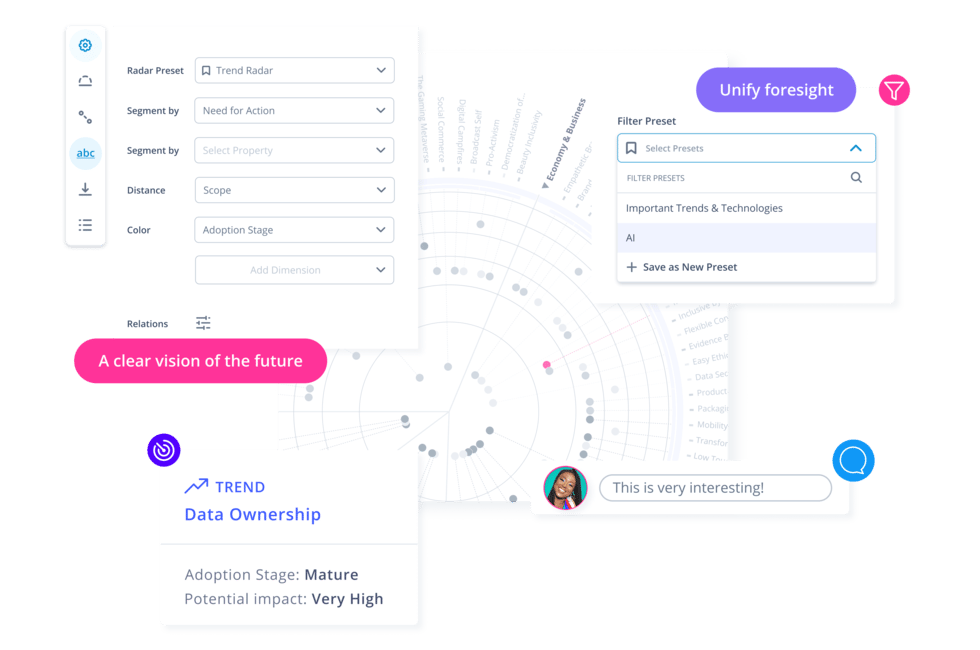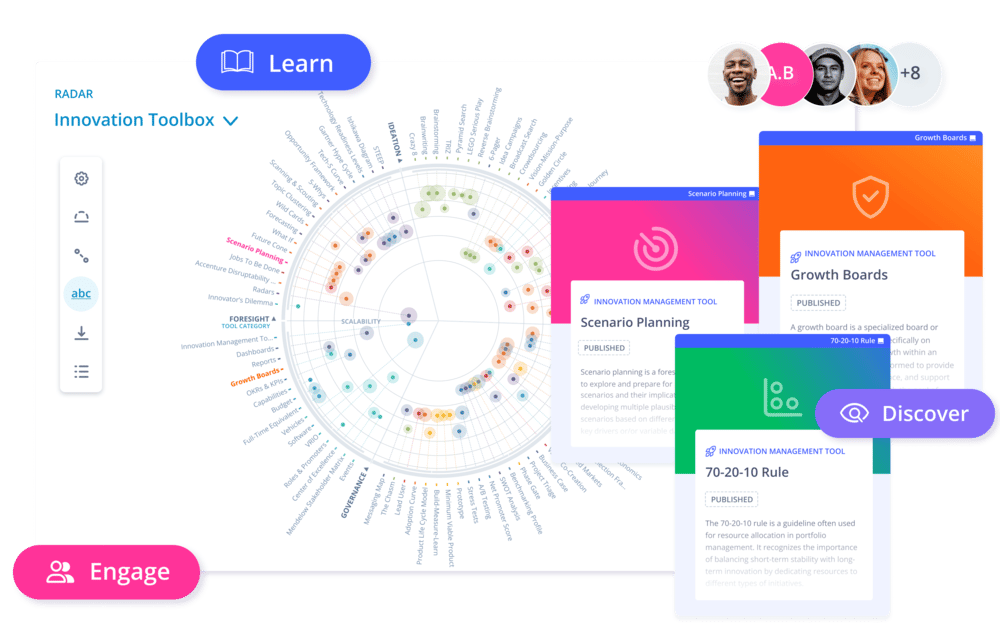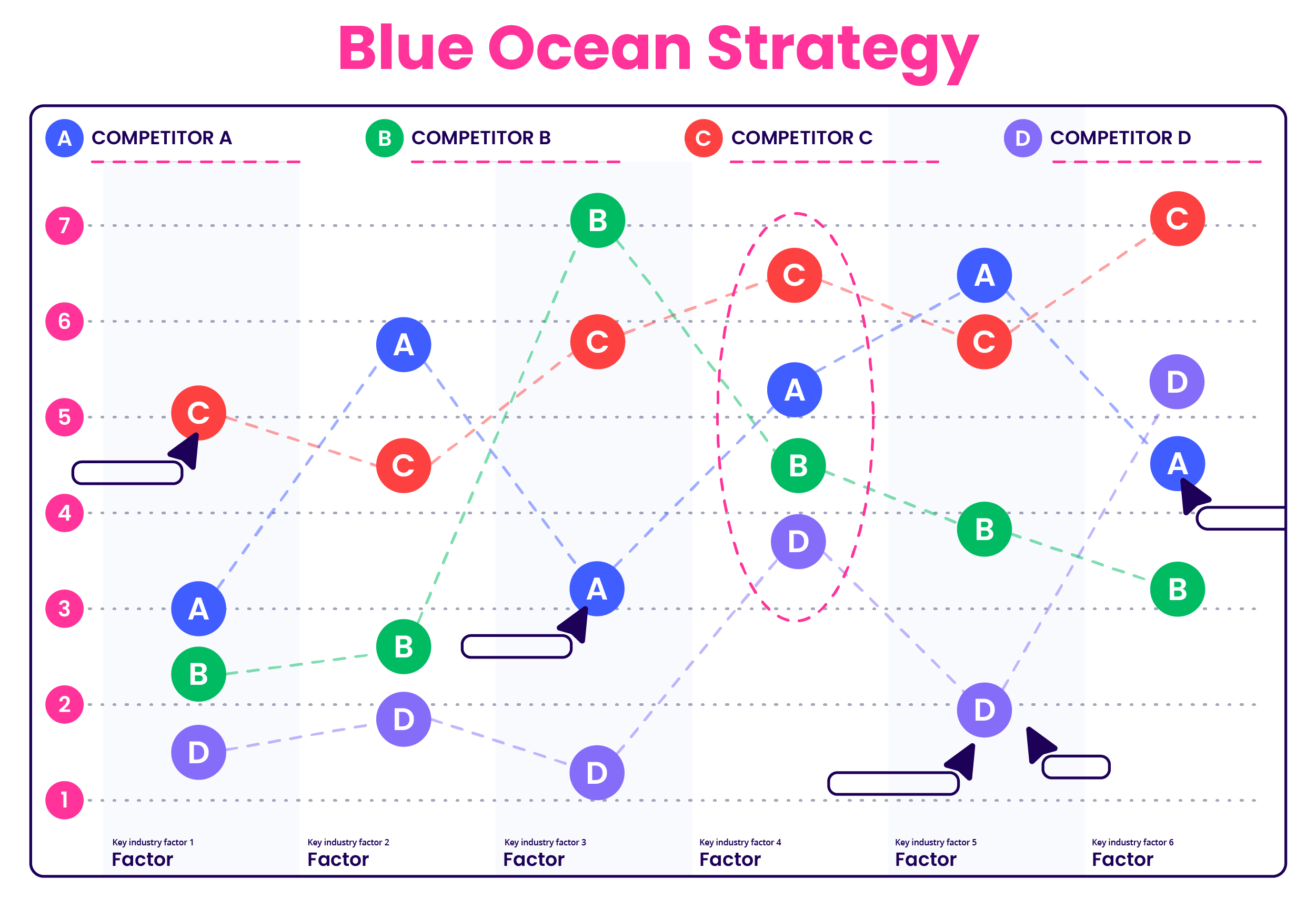It’s easy to get lost in innovation theatre.
Hundreds of books, articles, and frameworks are published each month, each claiming to be the silver bullet to outpace the competition. But let’s be honest: only a few make a real difference.
We’ve cut through the buzzwords to bring you the most powerful innovation methods, straight from the best books out there. Whether you're solving complex problems, testing bold ideas, or just trying to get unstuck, these tools work.
Let’s dive into the methods that move the needle.
What are innovation methods?
Innovation methods are structured techniques that help individuals and teams fix problems, generate ideas, and turn those ideas into real-world benefits. These methods are part of a broader innovation process that typically includes stages like idea generation, testing, refinement, and scaling.

Whether you’re launching a new product, improving a service, or rethinking internal operations, innovation methods offer a systematic approach to move from uncertainty to clarity.
Commonly used innovation tools include Design Thinking, which concentrates on human-centered solutions, and the Lean Startup methodology, which promotes rapid experimentation through minimum viable products (MVPs) and early customer feedback.
These approaches help reduce risk, align teams, and speed up development by avoiding wasted effort on ideas that don’t work. Innovation tools can be applied individually or in combination depending on the problem, team, and context.
They encourage collective intelligence, co-creation, and creative thinking, all while maintaining a repeatable innovation process.
Short answers and FAQs on the key innovation methods
What are the most important innovation methods?
Some of the most widely used innovation methods include Design Thinking, Lean Startup, Jobs-to-be-Done, TRIZ, and Outcome-Driven Innovation. These methods help teams understand customer needs, test ideas early, and bring new products or solutions to market with less risk.
Each method offers a structured way to solve problems and uncover new opportunities.
What’s the difference between an innovation method and a framework?
An innovation method is a step-by-step technique you apply to generate or test ideas, like running customer interviews or building a prototype.
A framework is a bigger-picture structure that helps guide decisions over time, such as the Business Model Canvas or the Three Horizons Framework. Methods focus on actions. Frameworks focus on structure and direction.
For what is applying innovation methods good for?
Successfully applied, innovation methods are useful for reducing uncertainty, improving customer fit, and turning ideas into outcomes.
These methods help you work in a more structured way, move faster, and avoid investing in ideas that won’t work. They’re also great for improving collaboration between teams. The opposite would be relying on lucky chance which is seldom a good management choice.
Which innovation method is best for large organizations?
For bigger organizations, a mix of methods works best. Use Design Thinking and Lean Startup at the team level for agility. Combine them with Stage-Gate or Zone to Win for governance and scaling.
The right structured approach depends on your goals and how your teams work.
Which innovation method should I apply first?
Start with methods that help you understand your innovation landscape. Use structured frameworks to map existing products, development processes and projects and identify weaknesses.
Next, use methods to understand your customer, like Design Thinking or Jobs-to-be-Done. These give you insight into real needs before you start building anything.
How does innovation management software support innovation processes?
A platform like ITONICS Innovation OS centralizes insights, streamlines idea capture and evaluation, tracks progress, and fosters collaboration across global teams.
For what domains do innovation methods exist?
Innovation methods can be applied across many domains and industries, from healthcare and finance to manufacturing, energy, education, and tech. While the problems in each field differ, the core innovation process, understanding needs, generating options, testing, and scaling, remains consistent.
In solution development, methods like Design Thinking and co-creation help teams build with users, not just for them. In strategic planning, frameworks like the Three Horizons or Innovation Ambition Matrix guide investment decisions across different stages.
In R&D-heavy industries, various methods support structured exploration, while in digital and creative fields, they fuel agility and creativity. More recently, different methods have also been adapted for collective intelligence, where ideas are sourced from crowds, customers, and open networks.
What unites all of these domains is the need for a structured yet flexible approach to fostering innovation. Whether you’re aiming to improve existing solutions or develop entirely new ones, innovation methods offer the tools to get there, with deep understanding, lean principles, and more collaboratively.
Navigate through the most powerful innovation tools and techniques to supercharge your innovation management, compiled and assessed by our experts.
The 21 most influential innovation methods from the best books on innovation
New idea generation and opportunity discovery
Great innovation starts with asking the right questions. This section presents innovation frameworks and innovation methods that help teams explore opportunities from different angles, whether through customer needs, cross-disciplinary thinking, or structured creativity.
Each approach helps identify problems worth solving for a defined target audience, laying the groundwork for impactful innovation.
1. Seven Sources of Innovation from Innovation and Entrepreneurship by Peter Drucker (1985)
Drucker identified seven reliable sources of innovation: unexpected occurrences, incongruities, process needs, industry changes, demographics, changes in perception, and new knowledge.
His core insight is that innovation is systematic, not random. The value lies in helping organizations focus on fertile ground for breakthrough ideas.
2. Jobs-to-be-Done (JTBD) from Competing Against Luck by Clayton Christensen (2016)
Jobs-to-be-Done reframes innovation around what people are trying to accomplish, their "jobs", rather than their demographics. Customers hire products and solutions to solve specific problems in their lives.

The framework uncovers hidden opportunities by focusing on unmet needs. It shifts product design from features to outcomes, enabling more targeted, value-driven innovation.
3. Outcome-Driven Innovation from What Customers Want by Anthony Ulwick (2005)
Outcome-Driven Innovation (ODI) begins with identifying the measurable results customers want and ranking unmet outcomes by importance and satisfaction.
This approach removes guesswork by quantifying customer needs. It enables more focused innovation, aligned with what truly matters to users.

4. Value Proposition Design from Value Proposition Design by Alexander Osterwalder and Yves Pigneur (2014)
Value Proposition Design offers a framework for aligning product features with customer pains, gains, and jobs. It helps teams visualize and iterate on testable hypotheses.

The contribution is turning customer-centricity into a structured design process. It reduces market misfit risk by testing assumptions early and often.
5. Design Thinking from Change by Design by Tim Brown (2009)
Design Thinking is a human-centered innovation approach that emphasizes empathy, ideation, and experimentation. Teams deeply understand user needs before rapidly prototyping and testing ideas. For systematically evaluating ideas, a three-lens framework was introduced to evaluate and guide innovation efforts by asking:
-
Desirability – Do people want this?
-
Feasibility – Can we build this with current tech and capabilities?
-
Viability – Can it work as a sustainable business?
Its key contribution is unlocking creative confidence and reducing failure risk. It democratizes innovation and keeps it grounded in real-world contexts.

6. The Medici Effect from The Medici Effect by Frans Johansson (2004)
The Medici Effect highlights how breakthrough innovations happen at intersections of disciplines, industries, and cultures. Diversity of perspective sparks novel combinations.
The concept encourages teams to break silos and explore unexpected connections. It shows that innovation isn’t just about depth—it’s about breadth and openness.
7. TRIZ from And Suddenly the Inventor Appeared by Genrich Altshuller (1984)
TRIZ is a structured approach to solving innovation problems using principles derived from analyzing thousands of patents. It offers 40 tools to resolve contradictions in systems.
The concept shifts innovation from brainstorming to engineering, providing a toolkit for repeatable, inventive problem-solving.
8. Blue Ocean Strategy from Blue Ocean Strategy by W. Chan Kim and Renée Mauborgne (2005)
Blue Ocean Strategy introduces the idea of creating an uncontested market space where competition becomes irrelevant. Instead of battling rivals in saturated markets, companies shift focus to value innovation, offering new value propositions that open up demand and unlock growth.
The core contribution is redefining competitive boundaries to make rivals obsolete. It equips organizations to break free from commoditization and grow through differentiation, not price wars.
9. Ten Types of Innovation from Ten Types of Innovation by Larry Keeley et al. (2013)
This framework categorizes innovation into ten types—from profit model and process to customer experience and brand. It encourages a broader view of where innovation can occur.
Its contribution is practical and strategic: combining multiple types leads to more defensible, high-impact innovations that competitors struggle to replicate.
Innovation process management and organisational structures
Turning ideas into results requires more than creativity and brainstorming sessions. It needs structure. The following innovation models guide how to organize innovation processes, teams, and decision-making processes to scale effectively.
This section explores different angles for building innovation capabilities that fit your target audience and company context, from open ecosystems to structured phases.
10. Stage-Gate Process from Winning at New Products by Robert G. Cooper (1993)
The Stage-Gate Process structures innovation into phases with go/kill checkpoints. It ensures new ideas are evaluated with evidence before advancing through development.
.webp?width=1045&height=693&name=iterative%20stage-gate%20processes%20(1).webp)
Its main contribution is governance, balancing creativity with discipline and ensuring that only the most promising concepts receive resources and attention.
11. Strategic Innovation from Ten Rules for Strategic Innovators by Vijay Govindarajan and Chris Trimble (2005)
Strategic Innovation defines how to manage new growth businesses inside existing organizations. It proposes separate structures and leadership for innovation initiatives to protect them from short-term performance pressures.
Its contribution is operationalizing long-term innovation. It enables firms to explore new markets while maintaining the performance of their core business. The ten rules can be described as:
-
Forget some of what you know
-
Borrow assets from the parent company
-
Learn how to learn
-
Allocate enough resources
-
Create a separate organizational identity
-
Maintain strong leadership support
-
Manage the partnership between the core and the new
-
Plan for scaling early
-
Track learning, not just outcomes
-
Don’t apply core business metrics to new ventures
12. Open Innovation Funnel from Open Innovation by Henry Chesbrough (2003)
Open Innovation argues that firms should use both internal and external ideas and paths to market. It breaks the closed R&D process model and promotes ecosystem collaboration.
The benefit is increased speed, cost-efficiency, and access to broader talent and technologies. It reframes innovation as a networked activity.
Evaluating ideas and validating assumptions
Not every idea should be built. This section covers innovation methods designed for idea evaluation, testing assumptions, and prioritizing solutions based on evidence.
These methods bring discipline to early innovation efforts, helping you move beyond intuition and focus resources on concepts that meet the needs of your target audience.
13. Business Model Canvas from Business Model Generation by Alexander Osterwalder and Yves Pigneur (2010)
The Business Model Canvas (BMC) provides a visual tool to describe, analyze, and iterate a business model across nine building blocks.

Its contribution is in making the generation of ideas collaborative and testable. It helps teams pivot quickly, align stakeholders, and explore new business model configurations without heavy documentation.
14. Build, Measure, Learn from The Lean Startup Method by Eric Ries (2011)
Instead of developing fully specified solutions based on assumptions, teams build a minimum viable product (MVP), test it with real users, measure outcomes, and learn what creates benefit. The concept prioritizes validated learning over elaborate planning.

This cycle shifts processes from intuition to evidence. It reduces waste, accelerates feedback loops, and enables organizations to pivot early if needed. The core contribution is turning new idea generation into a repeatable process rooted in learning, not just execution.
15. Metered Assumption Testing from Discovery-Driven Growth by Rita McGrath and Ian MacMillan (2009)
Metered assumption testing is the idea behind discovery-driven planning. It is foremost useful for evaluating early-stage ideas under high uncertainty. Rather than relying on forecasts or detailed business plans, teams start by identifying the key assumptions that must be true for an idea to succeed.
Each assumption is tested systematically, with progress tied to learning milestones and staged investments. The core contribution lies in minimizing risk while maintaining ambition. By allocating resources incrementally, only as assumptions are validated, organizations avoid overcommitting to unproven ideas.
This approach enables faster pivots, smarter resource use, and greater confidence in scaling only what works. It's especially useful when entering unknown markets, launching new ventures, or experimenting with novel business models.
Innovation methods to accelerate customer adoption
Even the best ideas can fail without adoption. This section highlights innovation methods that help you understand how ideas spread, how to cross the adoption gap, and how to position solutions effectively for finding new lead users.
These methods provide essential tools for scaling new ideas and reaching broader markets.
16. Crossing the Chasm from Crossing the Chasm by Geoffrey A. Moore (1991)
Crossing the Chasm explains why many innovations fail to move from early adopters to the mainstream market. It highlights the need to reposition, repackage, and refocus solutions to appeal to pragmatists.

Its strategic contribution is a roadmap for scaling innovations beyond niche users into broad, sustainable markets.
17. Diffusion of Innovation & Bass Model from Diffusion of Innovations by Everett Rogers (1962, with later additions by Frank Bass)
Rogers' model outlines five adopter types, innovators to laggards, and five key factors influencing adoption. Frank Bass added a mathematical diffusion model to predict adoption curves based on social contagion.

Together, they offer a foundational framework for understanding how innovations spread along innovation S-curves and how to tailor adoption strategies for each segment.
Characteristics of innovators
Behind every breakthrough is a mindset. This section looks at innovation methods that focus on the personal skills, behaviors, and thinking patterns of intrapreneurs.
Understanding these traits helps teams build an innovation culture from the ground up—and identify the people best equipped to tackle challenges from different angles.
18. The Innovator’s DNA from The Innovator’s DNA by Jeff Dyer, Hal Gregersen, and Clayton Christensen (2011)
The Innovator’s DNA identifies five key behaviors, questioning, observing, networking, experimenting, and associating, that drive individual innovation capacity.
Its core insight is that innovation can be cultivated. By training these behaviors, organizations can develop more adaptive and creative leaders.
Innovation portfolio management
Managing new developments is about choosing the right mix. This section introduces methods that help organizations balance short-term wins with long-term bets.
By aligning activities with strategic goals, these tools ensure resources are allocated wisely across projects with different risk levels, timelines, and potential impact. Think of it as smart investing - for your new development pipeline.
19. Competitive Positioning Options from Competitive Advantage by Michael E. Porter (1985)
Porter’s Competitive Positioning Options explain how firms can outperform competitors by positioning along cost leadership or differentiation and optimizing their value chain activities accordingly.
Its contribution lies in linking innovation directly to business strategy. Companies can innovate deliberately across operations, product design, and delivery systems by analyzing where benefit is created and lost.
20. Three Horizons Framework from The Alchemy of Growth by Baghai, Coley, and White (1999)
The Three Horizons Framework divides innovation efforts into three time horizons: optimizing the core (H1), nurturing emerging opportunities (H2), and pursuing disruptive bets (H3).

It helps leaders allocate resources strategically across short-, medium-, and long-term growth. The contribution lies in balancing stability and renewal without cannibalizing either. Bansi Nagji and Geoff Tuff (2012) further developed the concept into the innovation ambition matrix.
21. Zone to Win from Zone to Win by Geoffrey Moore (2015)
Zone to Win introduces a framework for structuring innovation efforts within bigger organizations by dividing them into four distinct “zones”: Performance (core business operations), Productivity (cost optimization), Incubation (early-stage innovation), and Transformation (scaling disruptive bets).
Each zone has its own metrics, culture, and resource model to prevent conflicts between short-term execution and long-term projects.
The core contribution of this approach lies in its practical guidance for managing ambidexterity, balancing operational excellence with the pursuit of breakthrough growth. It’s especially relevant for companies trying to scale disruptive ideas without jeopardizing their existing business. Moore’s model offers a governance blueprint for innovation at enterprise scale.
How to best make use of the different innovation methods
To get the most from the various methods, it’s important to match them to the stage of your innovation process and the type of challenge you’re solving. Whether you're aiming to generate ideas, test solutions, or scale a product, each method offers different strengths.
Start with a structured ideation process. Methods like Design Thinking help teams frame problems, involve users, and generate creative solutions based on real needs. These approaches promote customer-centric thinking by involving customer engagement early, often through interviews, rapid experimentation, or digital surveys.
To go beyond incremental improvements, use methods that encourage unconventional ideas and different perspectives. Collective brainstorming, creative prompts, and interdisciplinary teams can help unlock bold thinking, especially when tackling complex problems.
Digital platforms also play a key role. They support remote collaboration, idea voting, and transparent feedback, allowing larger groups to contribute. This is especially valuable when trying to identify areas of opportunity across functions or markets.

Once ideas are generated, other methods help prioritize what to explore further. Use criteria like feasibility, desirability, and potential impact to decide which concepts to prototype or test. Methods like Lean Startup and rapid prototyping enable small experiments that quickly build knowledge and reduce risk.
In short, the best way to apply innovation methods is not to pick just one, but to combine them thoughtfully—using each where it fits best in your journey. Build on creativity, structure your thinking, and keep the customer at the center of your innovation process.
Start innovating systematically. Today, with ITONICS, the best innovation tool.
The ITONICS Innovation OS is the best innovation management software. Our Innovation OS embodies all the essentials of the best innovation management software and covers all the application areas in one tool.
/Still%20images/Portfolio-product-header-1000px.webp?width=1000&height=629&name=Portfolio-product-header-1000px.webp)
It will help you to:
Eliminate Information Silos: Dispersed teams and disconnected data often result in missed opportunities and duplicated efforts. With ITONICS, all your project knowledge, most innovative ideas, and market insights are centralized in one digital platform. Create transparency and reduce inefficiencies by keeping everyone on the same page.
Streamline Idea Management: Managing a high volume of ideas from various sources can be overwhelming. ITONICS allows you to generate ideas and prioritize ideas from across the organization, including customers and partners, all in one structured ideation process. This helps focus resources on the most impactful ideas and reduces time wasted on less promising ones.
Track progress across teams: Monitoring the progress of multiple projects across departments isn’t easy. ITONICS provides visual dashboards and automated reporting tools that give you a real-time overview of ongoing projects, ensuring you can quickly address roadblocks, identify risks, and keep everything on track.
Foster a culture of experimentation: Innovative breakthroughs often come from collaboration. ITONICS enables your teams to collaborate in real time, regardless of location, by sharing insights, knowledge, and updates directly within the digital platform. This fosters a culture where great ideas can emerge from diverse perspectives.







